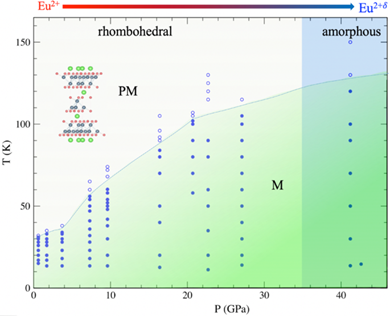Revealing the rich phases in topological magnet EuSn2P2 by high pressure
Magnetic topological systems promise great potential applications in future dissipationless electronics due to their interplay of magnetism and topological quantum states. Since the discovery of the first intrinsic topological magnet MnBi2Te4, much effort has been placed in a series of Eu-based compounds for the rich phases such as strong local moment, valence fluctuation, and Kondo physics. A recently published work investigated the pressure tuning of magnetism, valence, crystal lattice, and topological state in a topological magnet EuSn2P2 under high pressure using a combination of 151Eu synchrotron Mössbauer spectroscopy, X-ray absorption, X-ray diffraction, and band structure as well as molecular orbital calculations. In this work, it has been found that by applying pressure of 41.2 GPa the magnetic ordering temperature is enhanced by fourfold, despite a transition from Eu2+ toward Eu3+. In addition, EuSn2P2 transforms from a rhombohedral lattice to an amorphous phase above 36 GPa. Even in the disordered lattice, a magnetically ordered state is maintained. These intriguing results present EuSn2P2 as a fascinating playground to explore a multitude of phenomena.
This work involves collaborative efforts of researchers from University of Alabama at Birmingham, the State University of New Jersey-Rutgers, National Cheng Kung University, and Argonne National Laboratory. The high-pressure experiments were conducted at Argonne X-ray Science Beamlines 3ID and HPCAT (16ID-D) as well as PX2 (13BM-C) beamline at GSECARS.
For more, see: Drastic enhancement of magnetic critical temperature and amorphization in topological magnet EuSn2P2 under pressure. W. Bi, T. Culverhouse, Z. Nix, W. Xie, H.-J. Tien, T.-R. Chang, U. Dutta, J. Zhao, B. Lavina, E.E. Alp, D. Zhang, J. Xu, Y. Xiao, and Y.K. Vohra, npj Quantum Mater. 7, 43 (2022).

